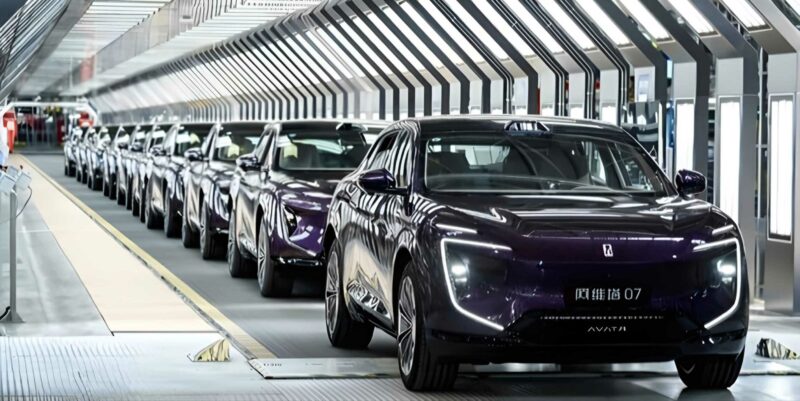On September 9, Chen Zhuo, president of Avatr, announced that the Avatr 07 has rolled off the production line in Chongqing, China, and will be officially launched on September 26.

The pre-sale opened on August 30, available in BEV and EREV variants, sit on an 800 V architecture. The pricing information has not been announced at this time.


- BEV RWD: 252 kW (338 hp) electric motor
- BEV AWD: 252 kW electric motor + 188 kW (252 hp) front electric motor, 0 – 100 km/h acceleration time of 3.9 seconds
Both the RWD and AWD are equipped with lithium iron phosphate battery packs provided by CATL, providing a CLTC cruising range of 650 km and 610 km, respectively.
- EREV RWD: Changan’s self-developed Kunlun range-extender system composed of a 115 kW (154 hp) 1.5T engine + 231 kW (310 hp) electric motor
- EREV AWD: same range extender & rear electric motor + 131 kW (176 hp) front electric motor, 0 – 100 km/h acceleration time of 4.9 seconds, top speed is 190 km/h
The 39.05 kWh lithium iron phosphate battery pack provides a CLTC pure electric range of 230 km and 220 km, respectively.

The Kunlun range-extender system features an intelligent control system. In scenes such as uphill and downhill, the torque can be adjusted according to the actual road conditions, reducing 60% of the accelerator pedal changes and braking frequency.

The Avatr 07 measures 4825/1980/1620 mm, and the wheelbase is 2940 mm, positioned as a mid-size SUV. The official claimed that the Avatr 07 has more than 30 design optimizations to reduce the drag coefficient and adopts the New Emotive Luxury design concept.

Additionally, the car’s intelligent driving system is powered by Huawei Qiankun ADS 3.0, realized via 27 sensors, including a 192-line lidar.

At the same time, the Avatr 07 has a dual-motor intelligent assisted U-turn radius of 3.2 m. Other technologies include the iGVC intelligent turning vector control system that distributes the vehicle torque when turning to make the turn more smoothly; iSTC intelligent steering torque control system that provides precise steering assist by real-time monitoring of the vehicle’s steering torque and steering angle; and Taihang Intelligent Control Chassis, achieving a moose test speed of ≥82 km/h and a 100 – 0 km/h braking distance of <34.5 m.

The cockpit powered by Huawei’s Harmony OS 4.0 adopts a four-screen layout composed of a 35.4-inch integrated extra-long screen, a 15.6-inch horizontal central control screen, and two 6.7-inch screens at each end for streaming the digital side mirrors. The center console is equipped with mobile phone wireless charging and two cup holders.


The front seats are zero-gravity type, wrapped in Nappa leather, and support 8-point massage + 16-way electric adjustment. There are also 39 ambient light sources throughout the interior, with the longest light strip being 2854 mm.


Furthermore, there are 25 speakers for the audio system with a peak power of 2016 W and a 1.1 m2 panoramic sunroof.






Source: Avatr, Weibo, QQ News, qctt



